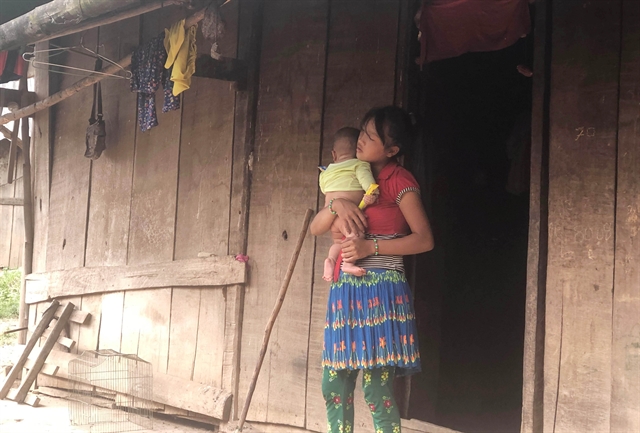 Society
Society

 |
| A girl in Cốc Pàng Village, Cốc Pàng Commune in Bảo Lạc District is a mother at just 15 years old. — VNA/VNS Photo Chu Hiệu |
CAO BẰNG — Child marriage and consanguineous (blood-related) marriage have existed for a long time in ethnic groups in the northern mountainous province of Cao Bằng.
The problem leaves many serious consequences for their physical and mental development.
It is also a great barrier to learning and education for girls.
Cao Bằng Province has proposed solutions towards ending child marriage in ethnic groups in remote areas by 2025.
Làng Lỷ Village in Nội Thôn Commune, Hà Quảng District has 37 households of Mông and Nùng ethnic groups living together.
Due to the mountainous terrain, difficult roads, lack of access to clean water for daily life, and infrequent phone signal, people's lives are still very hard.
From 2015 up to now, the village had four cases of Mông child marriages.
Trương Văn Thắng, head of the village, said that most child marriage cases were students who left school early, worked in the fields, and had limited knowledge of marriage and parenting skills.
Thống Nhất Commune in Hạ Lang District is a border commune with more than 700 households of Nùng and Tày ethnic groups.
Over 50 per cent of them are poor and near-poor households.
In the past year only, Thống Nhất Commune had four child marriages.
Chairman of Thống Nhất Commune People's Committee Chu Văn Đình said that to put an end to child marriage, the committee coordinated with different organisations to establish three clubs for legal education in many villages including Nà Kéo, Pác Lung, Kênh Nhiều, Nà Hoạch, Đoàn Kết, Bản Lạn and Nà Lụng.
Clubs maintain regular activities once a month with 164 members.
Preventing and sanctioning child marriage cases has been implemented timely and seriously, contributing to a reduction in child marriage in the commune compared to previous years.
Hà Quảng is a highland and border district, mainly inhabited by ethnic groups.
The poverty rate there is still quite high.
Local residents have limited awareness, intellectual and legal knowledge. Many outdated customs still exist in people's lives.
From 2015 to 2023, the district had 353 child couples married, of which, 154 Mông were ethnic couples and 90 were Dao ethnic couples.
The whole district has 13 blood-related married couples.
Head of the Hà Quảng District Ethnic Groups Affairs Division Nông Văn Nhất said that the district has implemented two pilot models to reduce child marriage and consanguineous marriage in ethnic groups for the period of 2015-25.
The models were implemented in Thanh Long and Nội Thôn communes.
Based on the results of these models, the district has promoted education to change the awareness and responsibilities of local people.
The district organises training and health workshops in villages, communes and towns to improve their knowledge and skills.
In the past three years, Cao Bằng Province had 666 cases of child couples in wedlock.
Most of them are from the Mông, Dao, Lô Lô and Nùng ethnic groups.
The province saw six consanguineous marriages.
This year, Cao Bằng Province implemented seven measures in districts and communes at high risk of child and consanguineous marriage.
Fund for the work is from the State budget, which is over VNĐ10 billion (US$422,800).
The province aims to reduce the average number of child marriages by two to three per cent each year.
Bế Văn Hùng, head of the Cao Bằng Ethnic Groups Affairs Committee, said the province would promote education on legal provisions related to legal marriage and child marriage.
The committee would also clarify the consequences and harms caused by this issue.
The province would also implement projects in the national target programme for socio-economic development in ethnic groups and mountainous areas in the period 2021-25.
The projects were expected to improve living standards and infrastructure in ethnic group areas, and boost the local economy, while raising awareness for ethnic people, and strictly enforcing laws related to child marriage and consanguineous marriage prevention and control. — VNS




